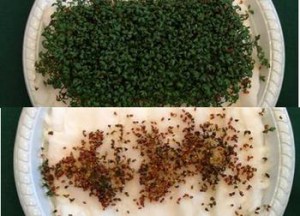High school experiment attracts interest from scientists across Europe
Does radiation from wi-fi routers and cell phones have health consequences? That’s the question five high school girls in Denmark set out to answer in an experiment that has scientists buzzing.
There have, of course, been numerous studies trying to determine whether cell phone radiation is dangerous, but wi-fi hasn’t received much attention so far. That may change given the results of the biology class experiment by the students at Hjallerup School in North Jutland, Denmark.
The students were having trouble concentrating as they tried to come up with a topic for their experiment. The more they thought about it, the more it seemed a topic that warranted further investigation.
In photo: Healthy cress seeds (top) were not exposed to wi-fi radiation, unlike the diseased cress (bottom). DR Photo
“We all thought we experienced concentration problems in school if we slept with our mobile phones at the bedside, and sometimes we also found it difficult sleeping,” explained Lea Nielsen, one of the five budding researchers, according to the Danish news agency DR.
A simple solution
Testing the effects of cell phone radiation on humans was, wisely, seen as beyond the capabilities of a high school class, so the girls came up with the idea of using simple cress seeds and a wi-fi router.
They took 400 cress seeds and divided them into 12 trays. Six of the trays were placed in one room, six in another. They all got the same amount of water and sunlight over 12 days. The only variable was that six of the trays were placed next to two wi-fi routers.
They waited 12 days, preparing to measure and weigh the different sets of seeds to see if they could find any significant differences. It didn’t take much measuring — the seeds in the trays next to the routers failed to grow. Some mutated. Many died.
The other seeds, the ones that weren’t next to the routers? They were fine, thanks.
“It’s really frightening that there was such a big effect, and we were really struck by the results,” said Nielsen.
The experiment, though simple, has attracted a lot of attention from prominent European researchers.
“Within the limitations of their understanding and ability, the girls have carried out and documented a very elegant piece of work. The wealth of detail and precision is exemplary, the choice of the right cress is very intelligent, and I could go on,” said Professor Olle Johanson of the Karolinska Institute in Stockholm, DR reported.
Source: Consumer Affairs
